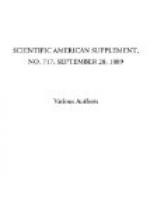[Illustration: FIG. 3.]
[Illustration: FIG. 4.]
[Illustration: FIG. 5.]
[Illustration: FIG. 6.]
The next point is the method of propulsion. Figs. 7 and 8 give an elevation and plan of one of the experimental carriages. Along the under side of each of the carriages a straight turbine, L L, extends the whole length, and water at high pressure impinges on the blades of this turbine from a jet, M, and by this means the carriage is moved along. A parabolic guide, which can be moved in and out of gear by a lever, is placed under the tender, and this on passing strikes the tappet, S, and opens the valve which discharges the water from the jet, M, and this process is repeated every few yards along the whole line. The jets, M, must be placed at such a distance apart that at least one will be able to operate on the shortest train that can be used. In this turbine there are two sets of blades, one above the other, placed with their concave sides in opposite directions, so that one set is used for propelling in one direction and the other in the opposite direction. In Fig. 6 it is seen that the jet, M, for one direction is just high enough to act against the blades, Q, while the other jet is higher, and acts on the blades, P, for propulsion in the opposite direction. The valves, R, which are opened by the tappet, S, are of peculiar construction, and we hope soon to be able to give details of them. Reservoirs (Fig. 6) holding water at high pressure must be placed at intervals, and the pipe, T, carrying high pressure water must run the whole length of the line. Fig. 6 shows a cross section of the rail and carriage, and gives a good idea of the general arrangements. The absence of wheels and of greasing and lubricating arrangements




